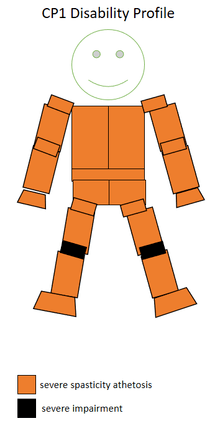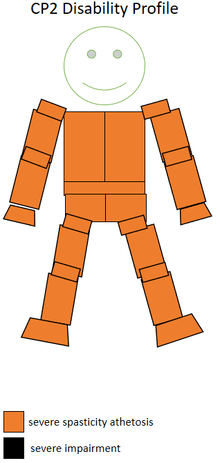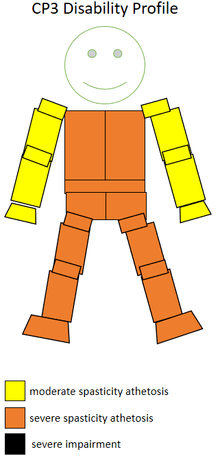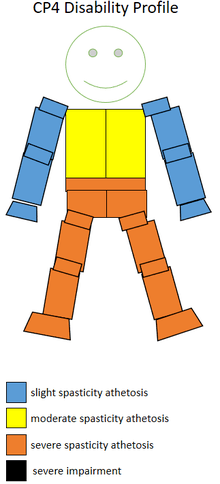T1 (classification)
T1 is a para-cycling classification. It is for athletes with severe locomotive dysfunctions, and insufficient balance to use a regular bicycle. The class includes a number of different disability types including cerebral palsy. The class only competes in road events and uses tricycles (hence the "T" in T1).
Definition
PBS defined this classification as "Tricycle 1 (T1) is for athletes with severe locomotor dysfunction and insufficient balance for cycling."[1] In 1997, this classification was defined by Alison Gray in Against the odds : New Zealand Paralympians as: tetraplegic - almost no use of trunk, arms and hands". Gray noted this classification was for wheelchair athletes.[2] The Telegraph defined this classification in 2011 as "T 1-2: Athletes on tricycles, who have severe locomotive dysfunctions and limited ability to pedal" [3]
Disability groups
 Disability type for CP1 classified sportspeople
Disability type for CP1 classified sportspeople Disability type for CP2 classified sportspeople
Disability type for CP2 classified sportspeople Disability type for CP3 classified sportspeople
Disability type for CP3 classified sportspeople Disability type for CP4 classified sportspeople
Disability type for CP4 classified sportspeople
The class includes people with cerebral palsy. CP1 to CP4 competitors may compete in the T1 class.[4][5][6] Tricycles are only eligible to compete in road events, not track ones.[4][6]
Cyclists with in this class are required to wear a helmet, with a special color used to designate their class. Male T1 competitors wear black helmets; T1 women wear blue helmets.[7]
Classification history
Cycling first became a Paralympic sport at the 1988 Summer Paralympics.[8] In September 2006, governance for para-cycling, including the responsibility for classification, passed from the International Paralympic Committee's International Cycling Committee to UCI.[9]
Becoming classified
Classification is handled by Union Cycliste Internationale.[10] Classification for the UCI Para-Cycling World Championships is completed by at least two classification panels. Members of the classification panel must not have a relationship with the cyclist and must not be involved in the World Championships in any other role than as classifier.[11] In national competitions, the classification is handled by the national cycling federation.[11] Classification often has three components: physical, technical and observation assessment.[11]
Events
At the 2012 Summer Paralympics, events for this classification include T 1-2 Road Race and Mixed T 1-2 Time Trial.[12]
Rankings
This classification has UCI rankings for elite competitors.[13]
See also
| Wikimedia Commons has media related to Cycling at the Paralympics. |
References
- ↑ "Competition at the Highest Levels, Cycling". Cycling. Retrieved 14 June 2012.
- ↑ Gray, Alison (1997). Against the odds : New Zealand Paralympians. Auckland, N.Z.: Hodder Moa Beckett. p. 17. ISBN 1869585666. OCLC 154294284.
- ↑ "London 2012 Paralympics: Road cycling guide". London: The Telegraph. 2011. Retrieved 14 June 2012.
- 1 2 Hutson, Michael; Speed, Cathy (2011-03-17). Sports Injuries. OUP Oxford. ISBN 9780199533909.
- ↑ "Classification Profiles" (PDF). Cerebral Palsy International Sports and Recreation Association. Cerebral Palsy International Sports and Recreation Association. Archived from the original (PDF) on August 18, 2016. Retrieved July 22, 2016.
- 1 2 "Clasificaciones de Ciclismo" (PDF). Comisión Nacional de Cultura Física y Deporte (in Spanish). Mexico: Comisión Nacional de Cultura Física y Deporte. Retrieved July 23, 2016.
- ↑ "AMENDMENTS TO REGULATIONS WITH EFFECT ON 01.01.2016 - PARTE XVI - PARA-CYCLING" (PDF). UCI. Retrieved 23 December 2016.
- ↑ "Cycling". 2012. Archived from the original on 2016-08-14. Retrieved Australian Paralympic Committee. Check date values in:
|accessdate=(help) - ↑ "Para-cycling High Performance". Australia: Cycling Australia. Retrieved 14 June 2012.
- ↑ "Guide to the Paralympic Games – Appendix 1" (PDF). London Organising Committee of the Olympic and Paralympic Games. 2011. p. 42. Retrieved 9 April 2012.
- 1 2 3 "UCI Para-cycling Classification Guide". UCI. 17 April 2012. p. 5.
- ↑ http://www.london2012.com/paralympics/cycling-road/events/index.html
- ↑ "Ranking — PARA — Cycling 2012". Union Cycliste Internationale. June 2012. Archived from the original on 13 June 2012. Retrieved 14 June 2012.